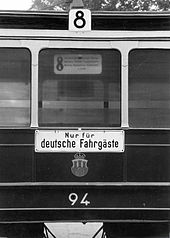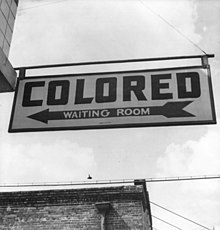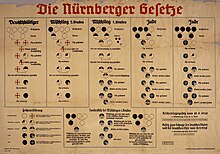racial segregation

Racial segregation is the racist , often economically motivated, compulsory spatial and social separation of groups of people defined as “races” in some or all areas of public and private life. Racial segregation was legitimized by racial laws and is a special form of sociological segregation .
The term races refers to groups of people and ethnic groups with different characteristics, such as: B. the appearance (hair, eyes, skin color, facial features, height, etc.). In the context of racial segregation, it is usually a term for the arbitrary delimitation of “one's own” social group from “others”, often with an overemphasis on an alleged “biological” difference and an alleged superiority or inferiority.
history
Racial segregation was mainly practiced during the colonial period up to the mid-1960s, but also in the former states with pronounced slavery (e.g. USA, Saudi Arabia, India), in some cases until today. As a rule, racial segregation included a ban on marriage (or any sexual contact) between members of the differently defined groups of people and ethnicities. Typically there were separate public institutions for members of different ethnic groups, for example public transport, restaurants, theaters and schools (see monoeducation ). The facilities for the ruling group are always better equipped than those for the marginalized groups. In the United States , segregation of African Americans was only used for the post- slavery period in the United States , when slaves were viewed as commodities rather than human beings . On the other hand, there was racial segregation towards the Indians from the beginning of the European settlement of America .
United States

The Chinese Exclusion Act restricted Chinese immigration to the USA in the 19th century, and further restrictions meant that Chinese people were only allowed to live in certain neighborhoods in the USA in the first half of the 20th century. The Chinatowns emerged .
After the abolition of slavery in the United States in 1865, the separation between African Americans and whites was established by the so-called Jim Crow Laws , which lasted until the 1960s.
Racial segregation was implemented in such a way that certain facilities were only allowed to be used by whites or only by blacks, i.e. there was a spatial separation, for example toilets only for whites and toilets for blacks (or "non-whites"). There was strict separation in the refreshment rooms (the "anteroom" of toilets with sinks and mirrors) or fitting rooms and drinking fountains in department stores, in buses blacks were only allowed to sit in the back (poorly ventilated) part, the whites sat in the front and in the one Black people were allowed to sit in the middle, provided that too few white people came along. There were also separation of places in railway wagons, (from) separate tables in restaurants and pubs or even local bans for blacks, there were separate elevators , park benches “only for whites” and the ban on taking part in primary elections. The racial segregation was signaled by signs.
In 1948, segregation in the US armed forces was abolished by President Harry S. Truman . Racial segregation (practiced among other things according to the principle of separate but equal in the southern states ) was abolished in all civil areas of the USA in 1964 by the Civil Rights Act of 1964 initiated by President Lyndon B. Johnson . Despite great progress, there are still clearly separated “black” and “white” residential areas.
In many prisons, prisoners divide themselves into groups. The prisoners themselves speak of racial segregation in this type of selection into “whites”, “blacks”, “Hispanics” and others. Certain parts of the prison are therefore often controlled by a specific group.
South Africa
The racial segregation policy in South Africa existed as a systematically conceived, state social model of "Separate Development" (apartheid) between 1948 and 1990. It was gradually abolished until 1994 in the course of social transformation. Frederik Willem de Klerk as President and Chairman of the National Party and Nelson Mandela from the African National Congress received the Nobel Peace Prize for the peaceful end to racial segregation.
Italy
Everyday life and society in Italian East Africa were characterized by a racial hierarchy from the start. In 1936, after the annexation of Ethiopia as a result of the Abyssinian War , the fascist system discovered the “race question” and racial segregation was legally introduced with the Racial Laws of 1937 and 1939 and the Mixed Breed Law of 1940. From 1938 onwards a number of racial laws and ordinances followed to protect the Italian race against the Jews.
Germany
The German Imperium
It was not until 1905 that the "civil marriage between whites and natives" was banned in the German colonies , as more and more male emigrants founded families with local women, which ran counter to the policy of social and economic racial segregation. Corresponding sexual relationships were ostracized by society in order to prevent an alleged " drugging ". In 1912 there was a mixed debate in the German Reichstag . The prohibitions existed until the loss of the colonies in 1918 as German colonial law and were then continued by the taking over colonial powers and supplemented by their own laws on racial segregation. The former German colonies only gained independence from Great Britain and France in the 1960s, and with it the repeal of all race laws.
time of the nationalsocialism

In 1933 the law to restore the civil service came into force. It was the basis for the removal of civil servants and employees of “ non-Aryan ” descent from the public service. In future, minorities such as Jews , Slavs , Sinti and Roma would no longer be allowed into the public service . The law against the overcrowding of German schools and universities restricted the access of “non-Aryan” pupils and students to the educational institutions; from 1939 on, Jewish pupils were no longer allowed to attend public schools at all.
In 1935 the “ Nuremberg Laws ” came into force. The content was the Blood Protection Act , which made marriage and sexual contact with nationals “German and related blood” a punishable offense for Jews and later also for “Gypsies, Negroes and bastards ” to “keep German blood clean”. In addition, the Reich Citizenship Law, which was also enacted, divided the German population into Reich citizens ("citizens of German or related blood") on the one hand and 'simple' citizens (members of "non-racial people") on the other. This created a three-tier legal system: citizens of the Reich, citizens and foreigners, each with lower rights.
In 1938 the ordinance to exclude Jews from German economic life followed , with which Jews were finally ousted from economic life. Before that, violent attacks and the “ Jewish boycott ” had forced many smaller traders and traders to give up their businesses. The " Aryanization " of the companies favored many " Aryans ". In the same year, Reich German Jews were also used outside of the camp system for forced labor in demarcated groups after they had been restricted from voluntary work due to professional bans . This should increase the pressure on them to emigrate. With the name change ordinance (second ordinance for the implementation of the law on the change of family names and first names of August 17, 1938, RGBl. I, 1044) of August 1938, Jews were required to use the additional first names Sara or Israel from 1939 onwards . This meant that people who were considered Jews under the racial laws could be recognized by their first names at any time.
In 1939 the law on tenancy agreements with Jews was passed , with which Jews were forced out of their tenancy agreements and accommodated in Jewish houses that were increasingly cramped. Because of the economic discrimination and the cramped living conditions, many had to sell their property to "Aryans" at cheap prices. The beautiful residential areas were usually first reported to be “ free of Jews ” and were also taken over by NSDAP party officials .
In 1941, the police ordinance on the identification of Jews in Reich territory made it mandatory to wear the “ Jewish star ” if one was considered to be a “Jew”. The regulation had previously come into force in occupied Poland in 1939 . The public should at all times be able to recognize the carriers as “inferior”.
Boycott of the Jewish department store "Wertheim" in Berlin, 1933
Memorial for a Polish slave laborer in Hamburg-Poppenbüttel
The Slavic peoples of Poland and Russia were considered by many Germans and especially by the National Socialists as "racially inferior" even during the Weimar Republic . According to the General Plan East , they were to be partially liquidated as part of the eastward expansion or to serve as cheap labor for simple work for the “Aryan master race ”. In 1940, with the Polish decrees (and later with the even stricter Eastern Workers' edicts ), a special right was created that allowed foreign " Eastern workers " (mostly forced laborers who were increasingly important for maintaining the war industry) to prevent espionage and " racial disgrace " from the Germans separated. Special markings were prescribed for the Polish and Russian Eastern workers. Special brothels were also built for “foreign workers” to prevent sexual contact with “Aryan” women.
Access to air raid shelters was forbidden to “Eastern workers” and Poles from 1942. For racial reasons, the Eastern workers were treated and cared for much worse than the Western European “ foreign workers ” who were forced to do so .
Occupied Territories

The racist bid "Just for German" particular during the Second World War in many countries occupied by Germany that certain facilities and transport were Germans reserved. Signs were posted at entrances to parks, cafes, cinemas, theaters, and other facilities.
In German-occupied Poland , racial segregation was almost complete. In trams and trains, the first wagon was usually reserved for German administrative and military personnel, NSDAP members and German civilians. On the secret order of Reinhard Heydrich to the Einsatzgruppen of the Security Police and the SD , after the end of the attack on Poland, the temporarily planned concentration of Jews in demarcated areas of Polish cities (later called ghettos ) began. There they should be more easily controlled and used as slave labor for economic exploitation. Their assets could also be systematically recorded there with the aim of Aryanization .
Polish partisans called inedible alcohol and poisonous black brand products "Only for Germans". The slogan was also painted on cemetery walls, or on street lamps as a reference to hanging on them.
See also
- Apartheid (law)
- Civil Rights Act of 1875 USA
- Civil Rights Act of 1964 USA
- Marcus Garvey
- Eugenics
- Racial equality proposal
Web links
- German Historical Museum The exclusion and persecution of the Jewish population
- Audio feature about the history of racial segregation in the USA on Bayern 2 Radiowissen.de
Individual evidence
- ↑ Chines - Exclusion - Immigration Library of Congress, accessed October 9, 2014.
- ↑ Gerd Presler: Martin Luther King. Rowohlt Verlag GmbH, 2017, ISBN 978-3-644-40200-3 ( limited preview in Google book search).
- ↑ a b David S. Kidder: Der SchlauerMacher. Mosaik Verlag, 2017, ISBN 978-3-641-22979-5 ( limited preview in Google book search).
- ↑ a b Hartmut Spieker: World power USA - has the decline begun? TWENTYSIX, 2018, ISBN 978-3-740-77523-0 , p. 359 ( limited preview in Google book search).
- ↑ Eric Metaxas: Seven Women Who Made History. SCM Hänssler, 2016, ISBN 978-3-775-17355-1 ( limited preview in Google book search).
- ↑ Maria Höhn: A touch of freedom ?. transcript Verlag, 2016, ISBN 978-3-839-43492-5 , p. 77 ( limited preview in Google book search).
- ↑ Aram Mattioli : Fascist Italy - an unknown apartheid regime. In: Micha Brumlik , Susanne Meinl , Werner Renz (eds.): Legal injustice. Racist law in the 20th century (= yearbook on the history and effects of the Holocaust. 2005). Campus, Frankfurt am Main et al. 2005, ISBN 3-593-37873-6 , pp. 155-178.
- ↑ Birthe Kundrus : Modern Imperialists. The empire in the mirror of its colonies. Böhlau, Cologne et al. 2003, ISBN 3-412-18702-X , p. 219 ff., (At the same time: Oldenburg, Universität, habilitation paper, 2002).
- ↑ Youth! Germany 1918–1945, Jewish youth accessed September 12, 2014.
- ↑ Götz Aly , Susanne Heim (ed.): The persecution and murder of European Jews by National Socialist Germany. 1933-1945. Volume 2: Susanne Heim: German Reich 1938 - August 1939. Oldenbourg, Munich 2009, ISBN 978-3-486-58523-0 , p. 50 ff.
- ↑ Renate Hebauf: Gaußstrasse 14. A “ghetto house” in Frankfurt am Main. The history of a house and its Jewish residents between 1912 and 1945. CoCon-Verlag, Hanau 2010, ISBN 978-3-937774-93-0 , pp. 73 ff.
- ↑ Michaela Freund-Aries: Women under control. Prostitution and its state fight in Hamburg from the end of the German Empire to the beginnings of the Federal Republic (= gender - culture - society. 8). Lit, Münster 2003, ISBN 3-8258-5173-7 , p. 174 ff. (At the same time: Hamburg, Universität, Dissertation, 2000).
- ↑ Michael Foedrowitz : Bunker Worlds. Air raid systems in Northern Germany. Ch. Links, Berlin 1998, ISBN 3-86153-155-0 , p. 119 ff.
- ↑ Ute Vergin: The National Socialist Labor Administration and its functions in the deployment of foreign workers during the Second World War. Osnabrück 2008, p. 426 ff. (Osnabrück, Universität, Dissertation, 2008; full text (PDF; 3.43 MB) ).
- ↑ deathcamp.org: Ghettos , accessed February 22, 2015.











